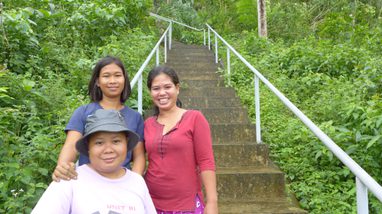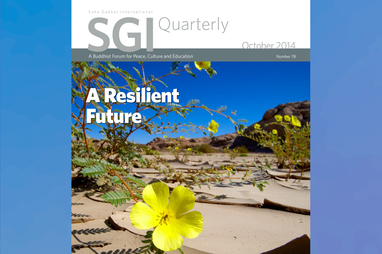SGI Quarterly

Andrew Zolli is a futures researcher, advisor and the author, together with Ann Marie Healy, of Resilience: Why Things Bounce Back. A central interest of his work has been how to harness the power of networks for shared discovery and collaboration, and for the past 12 years he has led PopTech, a community of global innovators collaborating on new approaches to global problems. He has also served as Fellow of the National Geographic Society. See www.andrewzolli.com
SGI Quarterly: What prompted you to pursue an active role in the field of resilience?
Andrew Zolli: Resilience isn’t a singular field, but rather a lens through which we hope to understand and help systems, places, organizations, communities and people contend with a world that is becoming increasingly volatile.
There is an emerging dialogue about resilience among systems scientists, urbanists, social activists, environmentalists, neuroscientists, organizational theorists, world leaders and spiritual leaders, among many others. The common denominator of these many conversations is an increasing appreciation that we live in a world of connected and unpredictable change, much of it now caused or amplified by human beings. We urgently need new tools to enable living systems to persist, recover or even thrive amid disruption.
Much of this dialogue began to take root in the West in the first decade of the 21st century. A decade marked by global acts of terrorism, a global financial crisis and unwinnable wars tore at the veil of certainty and control that previously dominated among elites. The traditional advantages of size and power seemed to confer less protection than they once did.
In their place, a sense has been growing among leaders in many fields that the global challenges we face—for example, extreme weather events due to climate change or global acts of terror—are no longer risks we can avoid or simply mitigate, but realities we have to learn, often painfully, to accommodate and adapt to.
This is one of the most important conceptual shifts of our new century, and I was excited to play a part.
While not every surprise can be predicted, the very act of designing a system to listen for change is an essential capacity for resilience.
SGIQ: What characteristics are essential to resilient systems, communities and individuals?
AZ: Resilience is often maddeningly parochial—the things that enable one person or system to “persist, recover or even thrive amid disruption” may not work for another, or at another time or in another circumstance. Resilience must continuously be repurchased anew. And yet there are themes, patterns and principles.
All resilient living systems do four things concurrently. First, they build regenerative capacity—that is to say, they build the kinds of capacities that continually renew the system. In a community, this might be measured in terms of the creative capacity of its citizens, or its level of education or entrepreneurship. Building this kind of capacity is a slow and often invisible process, but it is essential because these are the kinds of capacities that are drawn on when things go wrong.
A second thing resilient systems and people do is listen for change. While not every surprise can be predicted, the very act of designing a system to listen for change is an essential capacity for resilience. This is not merely a matter of signal detection, but of creating a whole ecosystem of detection, analysis and understanding, and acting on such signals.
The third thing resilient systems and people do is respond to disruption. Interestingly, throughout our travels we find that the most resilient responses to a disruption are rarely predetermined and bureaucratic; rather, they are what we call adhocratic—improvised, creative and collaborative.
Finally, there is a fourth thing that resilient, living systems do, and that’s learning and transformation. In the aftermath of a disruption, the system learns to better gird itself against the risk to which it was exposed, or it is transformed so that it is no longer vulnerable to that risk at all.
In a resilient system, or community or person, all of these processes are happening, to larger and lesser degrees, all the time—and there are feedback loops between them, each informing the other. This is true of the cells and immunological system in your body; true about the psychology of resilient people; it’s true of the systems that drive a city.
The fact that these very different kinds of things have similar kinds of “verbs” makes it possible to learn from strategies in one domain and apply them in another. For example, a group of researchers at the Santa Fe Institute is learning to apply the lessons of biological metabolism to cities so that we can learn to take biological strategies for resilience and apply them in very different contexts.

Construction underway in New Orleans’ Lower Ninth Ward [Photo credit: © Mario Tama/Getty Images]
SGIQ: You write in your book: “Wherever we found strong social resilience, we also found strong communities.” What are some properties of social resilience?
AZ: Without question, strong communities are essential to social resilience. Communities are the structures that give many people a sense of meaning, connection, purpose and agency. But the two most important resilience-factors they confer are trust and social coherence.
After Superstorm Sandy hit the northeastern United States, researchers found that in communities with the same levels of damage and resources, communities where residents reported trusting their neighbors rebounded more quickly than those that didn’t.
The second thing that communities confer is a sense of social coherence. In the aftermath of several terrible humanitarian disasters in areas like Sudan or Liberia, researchers working with the United Nations found that when communities were internally displaced by violence but could be kept intact, and where their culture was respected, psychological resilience had a much better chance of taking root.
SGIQ: You also describe the significance of “translational leaders.” Can you explain this?
AZ: To be real engines of resilience, communities require constant, authentic and flexible leadership. And in all of our travels, we frequently found one particular kind of leader. These were usually not at the “top” of the formal system, but rather, two or three levels down. They were natural translators between constituencies—connecting and brokering between the various subgroups within a community and between the community and outside institutions, networks, etc. We called these folks “translational leaders”—an idea we took from “translational medicine,” which itself is about turning theory into practice.
We urgently need new tools to enable living systems to persist, recover or even thrive amid disruption.
SGIQ: Can you give some examples of efforts to build and strengthen community that have inspired you?
AZ: In my research and travels, which have taken me from Haiti to South Africa to China and back again, there have been hundreds of examples. Here, I will mention just two:
If you were to take a stroll through the Lower Ninth Ward in New Orleans a few years after Hurricane Katrina, you would have seen something surprising. Look left, and you would see the busy efforts of people returning, rebuilding and recommitting to continuing their lives in a place where many had suffered unspeakable trauma, loss and grief. Look right, and you would see . . . nothing. No people, no rebuilding.
What was the difference? The difference in this case was the efforts of a woman named Pam Dashiell, an activist and community leader who wooed many to return from the post-storm diaspora. She has since passed away, but was a living embodiment of the ideas of translational leadership, and today many people are where they are because of her.
But communities do not have to be physical—under the right conditions, communities can emerge online that can also do mighty things. Here, I am reminded of a legendary project called “Mission 4636,” which emerged in the hours after the terrible earthquake in Port-au-Prince in 2010. Almost spontaneously, a group of global collaborators came together, comprised of technologists, humanitarians and members of the Haitian diaspora, and together they built a platform that enabled Haitian citizens to text their urgent needs via their mobile phones and have those needs translated, geolocated and responded to in a matter of minutes. What made this collaboration work was a sense of common purpose, shared humanity, deep urgency, strong (but distributed) leadership, trust and an innovative spirit. Most of the people who worked together on this still haven’t met one another in the “real” world, yet together they served many thousands.

People gather at a local restaurant in New York’s East Village during a power outage following Hurricane Sandy, October 30, 2012; trusting relationships between members of a community have been shown to increase resilience [Photo credit: © Allison Joyce/Getty Images]
SGIQ: What have been key lessons or principles in the work you have done to stimulate collaboration among innovators?
AZ: The world of human endeavor is largely organized into “silos of excellence”—the experts in public health speak to other experts in public health; the experts in climate change speak to other experts in climate change, and so on. This “siloing” is a natural and important aspect of working on really hard problems.
However, many of the most important solutions to our global challenges lie at the intersections between these fields and approaches—they emerge when we take an insight from discipline A and combine it with a tool from discipline B and an approach from discipline C. Increasingly, solving huge problems is not merely about discovering solutions. It’s about creating the right kinds of combinations of solutions.
And yet, you can’t merely throw very different experts into a room and command them to “Collaborate!” You have to create the time and space for people to begin to decode one another, to learn each other’s terminology and to produce their own new, hybrid insights.
In other words, you need to turn them from a disparate collection of experts into a “tribe” of people with different skills and expertise, but with shared values.
And so, we might ask, what makes a tribe? First, tribes are bound together by some basic shared observations, shared beliefs, and they need shared experiences and shared practices through which they can express them.
But to really catalyze collaboration, you also need less formal, open spaces and open time, in which people can develop trust, ask each other questions and generate and explore ideas naively without fearing they will look foolish. It requires a spirit of what the psychologist Rosamund Zander calls creative possibility.
To keep such a spirit alive requires respect, humility and careful facilitation rooted in a sense of “servant leadership” from people in positions of authority.
SGIQ: What direction do you see the field heading in the future?
AZ: Today, the resilience dialogue is still just getting going, and so it is still exciting, early days. There is much more important conceptual work to be done ahead of us than has been accomplished to date.
And yet, there are dangers present. First, there’s a real risk that the resilience narrative will be subsumed by more parochial institutions that will reduce it to an insubstantial buzzword or a proxy for their own day-to-day bureaucratic interests. That would be a shame—opportunities for openings in our language and organizational practices are rare, and we should use this one to think deeply about how to better serve the world.
Also, many institutions have been looking at resilience through the wrong end of a telescope—seeing it from miles above the clouds. And yet, when we see resilience, it’s often measured in far more local units—in the shift in the mindset and perspective of an individual, in a shift in empathy and compassion that leads to a shift in behavior. It’s my hope that this moment, in which the resilience dialogue is ascendant, can help return an appreciation for these “soft” factors to long-hardened institutions. The world will be much better for it.
Related Content


